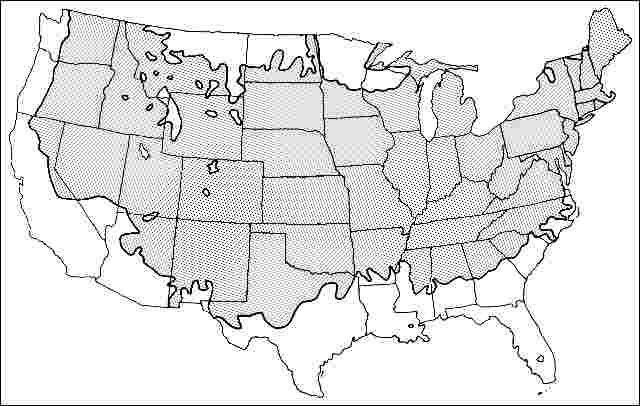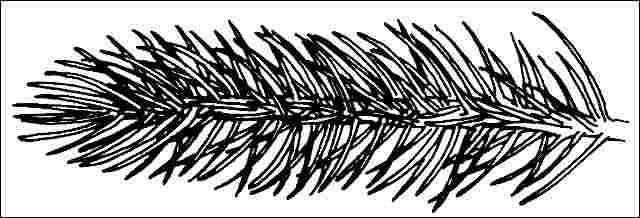Introduction
Colorado Spruce has a horizontal branching habit and grows taller than 75 feet in its native habitat, but is normally seen at 30 to 50 feet in landscapes. The tree grows about twelve inches per year once established but may grow slower for several years following transplanting. Needles emerge as a soft clump, changing to a stiff, pointed needle sharp to the touch. The crown form varies from columnar to pyramidal, ranging from 10 to 20 feet in diameter.

Credit: Ed Gilman
General Information
Scientific name: Picea pungens
Pronunciation: PIE-see-uh PUN-jenz
Common name(s): Colorado Spruce, Colorado Blue Spruce, Blue Spruce
Family: Pinaceae
USDA hardiness zones: 4A through 7B (Fig. 2)
Origin: native to North America
Invasive potential: little invasive potential
Uses: Christmas tree; specimen; screen
Availability: not native to North America

Description
Height: 30 to 50 feet
Spread: 10 to 20 feet
Crown uniformity: symmetrical
Crown shape: columnar, pyramidal
Crown density: dense
Growth rate: slow
Texture: fine
Foliage
Leaf arrangement: alternate (Fig. 3)
Leaf type: simple
Leaf margin: entire, terminal spine
Leaf shape: needle-like (filiform)
Leaf venation: parallel
Leaf type and persistence: evergreen, needled evergreen
Leaf blade length: less than 2 inches
Leaf color: blue or blue-green
Fall color: no color change
Fall characteristic: not showy

Flower
Flower color: orange, green, purple
Flower characteristics: not showy
Fruit
Fruit shape: oval, elongated, cone
Fruit length: 1 to 3 inches, 3 to 6 inches
Fruit covering: dry or hard
Fruit color: brown
Fruit characteristics: does not attract wildlife; not showy; fruit/leaves not a litter problem
Trunk and Branches
Trunk/bark/branches: branches droop; not showy; typically one trunk; thorns
Pruning requirement: little required
Breakage: resistant
Current year twig color: brown
Current year twig thickness: thick
Wood specific gravity: unknown
Culture
Light requirement: full sun, partial sun or partial shade
Soil tolerances: clay; sand; loam; acidic; alkaline; occasionally wet; well-drained
Drought tolerance: moderate
Aerosol salt tolerance: high
Other
Roots: not a problem
Winter interest: no
Outstanding tree: no
Ozone sensitivity: tolerant
Verticillium wilt susceptibility: resistant
Pest resistance: sensitive to pests/diseases
Use and Management
Colorado Spruce casts dense shade when branched to the ground, so no grass grows beneath it. Colorado Blue Spruce lends a formal effect to any landscape due to the stiff, horizontal branches, and blue foliage. It is often used as a specimen or as a screen planted 10 to 15 feet apart.
The tree prefers a rich, moist soil, and benefits from irrigation in dry weather. It is not for Dallas and south in Texas, but Lubbock and north into Oklahoma is suitable. Trees benefit from a layer of mulch extending beyond the edge of the branches. This keeps roots cool and reduces moisture loss from the soil. It grows in full sun or the shade on the north side of a building. It tolerates clay.
Susceptibility to canker makes this tree a questionable choice for large-scale planting in the eastern states. Substitute White Fir ( Abies concolor ) for the same blue foliage effect without the disease problem. Also, the wax coating on the needles which gives the blue color can be washed off by some pesticides. Check the label and test the spray on a small scale before spraying.
A number of cultivars are listed. The most common cultivar is `Glauca', the Blue Colorado Spruce. The blue trees are sometimes grown from seeds, so they vary in degree of blue coloration. For reliable blue color, purchase a grafted, named cultivar selected for its blue color. The list of cultivars is not long: `Argentea' (silver Colorado Spruce) - silvery foliage color; `Glauca' (blue Colorado Spruce) - bluish foliage; `Glauca Procumbens' - bluish foliage, height about two feet but spread several times the height; `Globosa' - three feet tall, blue foliage; `Hoopsii' - bluish foliage; `Iseli Foxtail' is a new Southern introduction and could be the most heat-adapted Blue Spruce--further testing will tell; `Moerhiemii' (Moerhiem Spruce) - compact, dense and very blue; `Pendens' (Koster's Blue Spruce) - weeping habit, must be staked to get it to take tree form, blue foliage; `Thompsoni' - bluish foliage.
Pests
Two gall-forming insects commonly attack Spruce. Eastern Spruce gall adelgid forms pineapple like galls at the base of twigs. Galls caused by Cooley's Spruce gall adelgid look like miniature cones at the branch tips. The gall adelgids do not kill trees unless the infestation is heavy. A few galls on a large tree are not serious.
In northern areas, Spruce budworm larvae feed on developing buds and young needles. The yellowish brown caterpillars are difficult to see.
The Spruce needle miner makes a small hole in the base of a needle then mines out the center. Dead needles are webbed together and can be found on infested twigs.
Pine needle scale is a white, elongated scale found feeding on the needles only. Populations would have to be quite high to cause major damage.
Aphids can cause needle defoliation.
Mites can be a serious problem in summer after hot dry weather. The small insects can't be readily seen with the naked eye. The first noticeable symptoms are yellowing of the oldest needles on infested branches. Close inspection with a magnifying glass will confirm the presence of the mites.
Diseases
Cytospora canker infects a branch then eventually kills it. The lower branches are attacked first then progressively higher branches. The needles turn brown to reddish brown and eventually drop off. White resin patches are seen on infected branches. Prune off infected branches. Water Spruces during dry weather but keep the foliage as dry as possible.
Spruce may be attacked by needle casts. One causes needles to turn yellow or brown and drop off. Another needle cast affects the lowest needles first then moves up the tree. Infected needles are a mottled yellow.
Several rust diseases attack Spruce but these are rarely seen. Infected needles turn yellow and drop off.